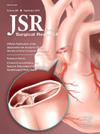Statewide Analysis of Pediatric Appendicitis Outcomes by Pediatric Surgeon Availability
IF 1.7
3区 医学
Q2 SURGERY
引用次数: 0
Abstract
Introduction
Appendicitis is common in children, treated by both pediatric and general surgeons at hospitals with varying specialization levels of pediatric care. We evaluated differences in treatment and outcomes by pediatric surgeon coverage using California's Department of Health Care Access and Information Database.
Methods
Children (≤17 y) with acute appendicitis (2019-2021) were identified. Those with significant comorbidities or could not be followed longitudinally were excluded. Hospitals were categorized as exclusively free-standing children's hospitals (ECH), other hospitals with pediatric surgeon coverage (WPS) or no pediatric surgeon coverage (NPS). Outcomes of initial intervention (appendectomy/drainage/nonoperative), readmissions, and complications were analyzed and stratified by appendicitis type (simple versus complicated).
Results
Of 7059 included patients, 33% were treated at ECH, 28% at WPS, and 39% at NPS. There were no differences in any outcomes for patients with simple appendicitis. Complicated appendicitis (n = 2755) was treated in greater proportions at ECH (43% ECH versus 38% WPS versus 37% NPS, P < 0.01). In complicated appendicitis, initial drain management was rare (n = 179) but more common in patients at ECH (9.1% ECH versus 5.2% WPS versus 4.9% NPS, P < 0.01). Readmissions were also rare (n = 181) but higher at ECH (8.4% versus 5% at NPS and WPS). Overall complication rates for complicated appendicitis did not differ by hospital type.
Conclusions
Although treatment strategies for appendicitis differed by hospital type, complication rates were equivalent regardless of surgeon coverage by hospital type. These results demonstrate that children with appendicitis in California overwhelmingly have positive outcomes regardless of the hospital's level of specialization in pediatric care.
全国范围内小儿阑尾炎结局的儿科外科医生可用性分析
阑尾炎在儿童中很常见,在儿科护理专业水平不同的医院,儿科和普通外科医生都有治疗。我们使用加州卫生保健获取和信息数据库通过儿科外科医生覆盖率评估治疗和结果的差异。方法对2019-2021年急性阑尾炎患儿(≤17岁)进行诊断。那些有明显合并症或不能纵向随访的患者被排除在外。医院被分类为完全独立的儿童医院(ECH)、有儿科外科医生覆盖的其他医院(WPS)或没有儿科外科医生覆盖的医院(NPS)。对初始干预(阑尾切除术/引流术/非手术)、再入院和并发症的结果进行分析,并按阑尾炎类型(单纯性和复杂性)分层。结果在7059例纳入的患者中,33%接受ECH治疗,28%接受WPS治疗,39%接受NPS治疗。单纯性阑尾炎患者的预后无差异。复杂阑尾炎(n = 2755)在ECH组的治疗比例更高(ECH组43% vs WPS组38% vs NPS组37%,P <;0.01)。在复杂阑尾炎中,初始引流管管理很少见(n = 179),但在ECH患者中更为常见(9.1% ECH vs 5.2% WPS vs 4.9% NPS, P <;0.01)。再入院也很少见(n = 181),但在ECH组更高(8.4%,而在NPS和WPS组为5%)。复杂阑尾炎的总并发症率没有因医院类型而异。结论虽然不同医院类型阑尾炎的治疗策略不同,但无论不同医院类型的外科医生覆盖率如何,并发症发生率是相同的。这些结果表明,在加州,绝大多数患有阑尾炎的儿童,无论医院在儿科护理方面的专业水平如何,都有积极的结果。
本文章由计算机程序翻译,如有差异,请以英文原文为准。
求助全文
约1分钟内获得全文
求助全文
来源期刊
CiteScore
3.90
自引率
4.50%
发文量
627
审稿时长
138 days
期刊介绍:
The Journal of Surgical Research: Clinical and Laboratory Investigation publishes original articles concerned with clinical and laboratory investigations relevant to surgical practice and teaching. The journal emphasizes reports of clinical investigations or fundamental research bearing directly on surgical management that will be of general interest to a broad range of surgeons and surgical researchers. The articles presented need not have been the products of surgeons or of surgical laboratories.
The Journal of Surgical Research also features review articles and special articles relating to educational, research, or social issues of interest to the academic surgical community.

 求助内容:
求助内容: 应助结果提醒方式:
应助结果提醒方式:


